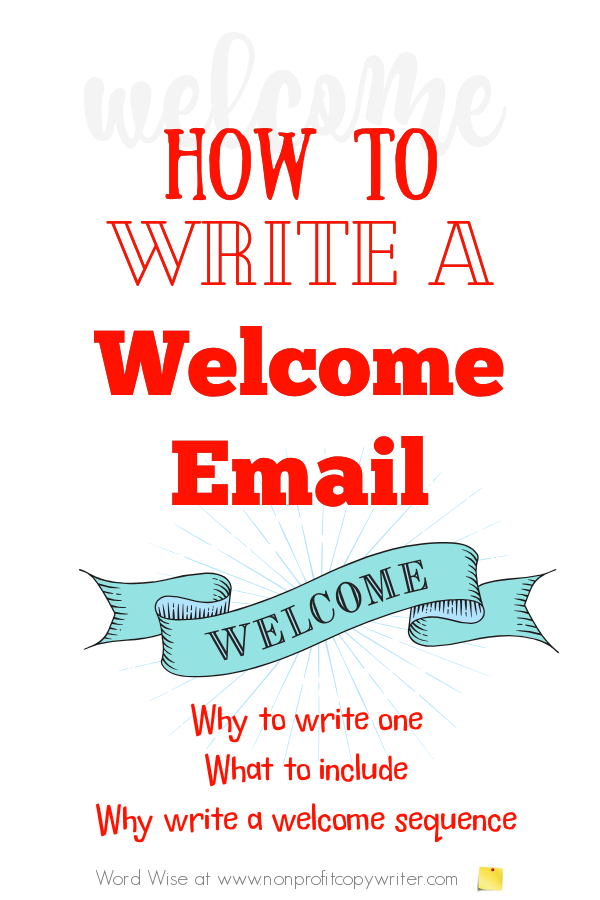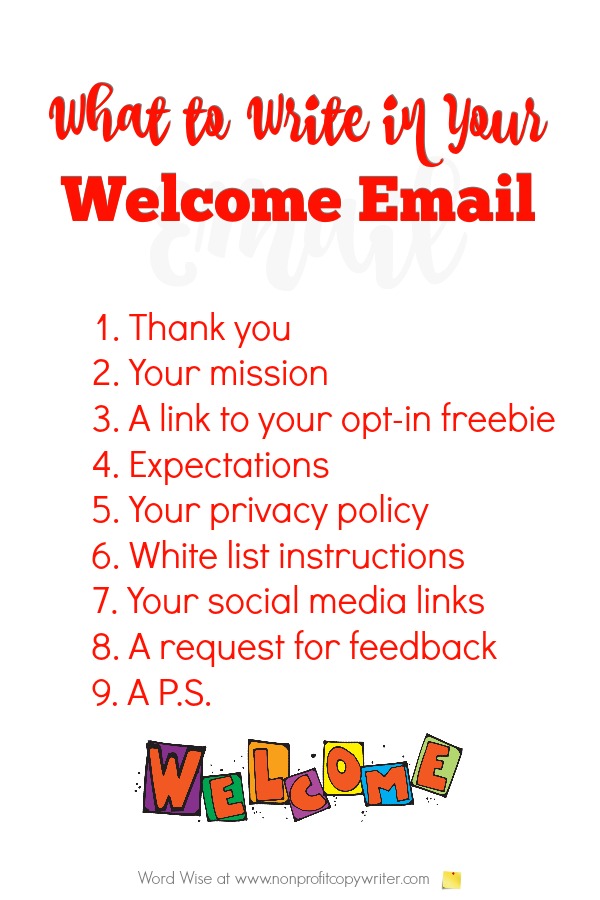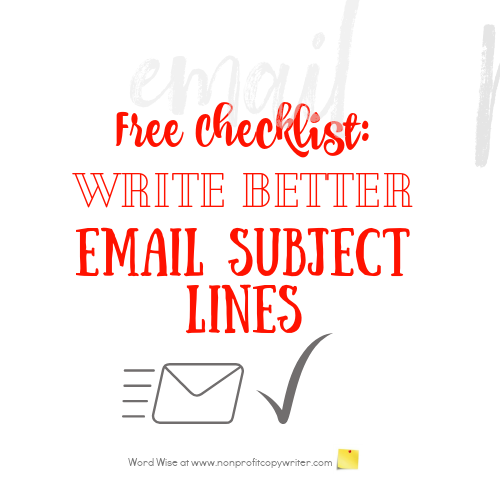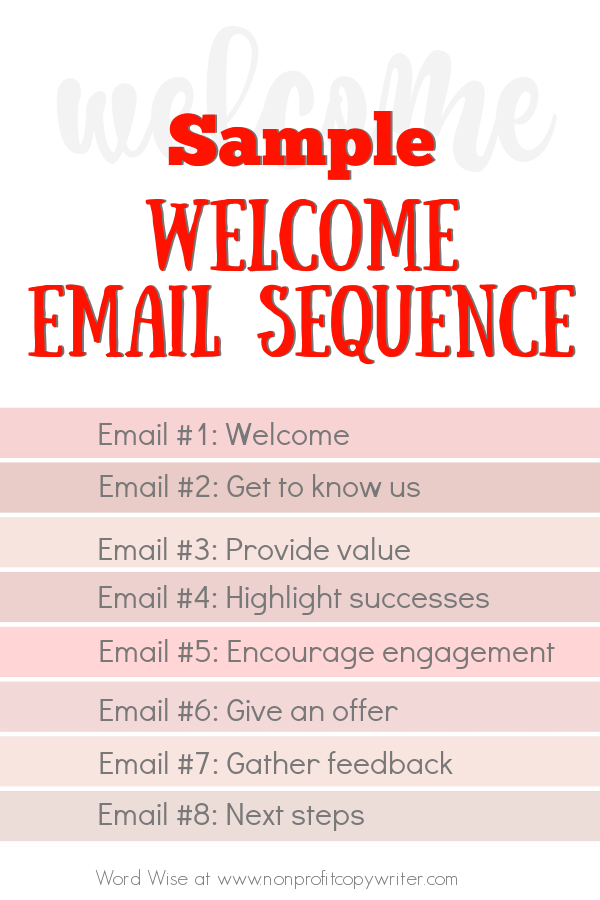Save Time: Get 5 Simple Writing Tips
you can put to use in 10 minutes
How to Write a Welcome Email to New Customers and Subscribers
Award-winning writer Kathy Widenhouse has helped hundreds of nonprofits and writers produce successful content , with 750K+ views for her writing tutorials. She is the author of 9 books. See more of Kathy’s content here.
Updated 6.17.24
Ping! Another subscriber notification pops into your box. What kind of welcome email did that new reader just receive from you?
A welcome email is the first email a newcomer has to interact with you afer making a purchase or opting in to your email list.
You can set up the email as an auto responder in your email list manager so that every new subscriber receives this email automatically once he has joined your list. Some offer welcome text already loaded into a prepared auto responder, which you can personalize.
Your welcome email is a wonderful opportunity to greet new readers personally and let them know you’re glad they’re a part of your community. But first …
Why you should write a welcome email
You’ve gone to some trouble to collect your reader’s email address, and with good reason. When it comes to acquiring true fans and customers, email is nearly 40 times more effective that of Facebook and Twitter combined, according to a McKinsey study.
That’s because 91 percent of all US consumers still use email every day. Your email list allows you to speak directly to those potential customers.
Writing a welcome email to new subscribers is a crucial step in building a strong relationship because …
- Your first impression to them matters
A welcome email is your chance to make a positive first impression. It introduces your brand, sets expectations, and establishes a foundation of trust and professionalism. A well-crafted welcome email can leave a lasting impact and encourage new subscribers to engage with your content and products. - Your friendliness builds a connection
By saying “Glad you’ve joined us,” you show that you value your new subscribers’ presence. You’re eager to have them as part of your community. Writing tip: personalize the email with the recipient's name or specific references to their interests and you can strengthen this connection. - You can set expectations
A welcome email is an opportunity to let new subscribers know what to expect from your communications. You can outline the type of content they will receive, how often they will hear from you, and any exclusive benefits they might enjoy. Clear expectations help reduce the chances of unsubscribes and increase engagement. - You can introduce your brand
New subscribers may not be fully aware of everything you offer. Use the welcome email to provide a brief introduction to your brand’s story, mission, and values. You can highlight your most popular products, services, or content to pique their interest and encourage further exploration. - You can guide readers' next steps
A welcome email can guide new subscribers or customers on what to do next: complete their profile, follow you on social media, explore your blog, or make their first purchase. A good welcome email includes a clear call-to-action to guide new subscribers and keep them engaged. - You can provide value from the start
When you offer a special discount, a free resource, or exclusive content in your welcome email you add immediate value and make new subscribers feel appreciated. That increases the likelihood that newcomers will stay engaged, rather than unsubscribing right away. - You can collect feedback
Ask new subscribers about their preferences or what they hope to get from your emails. For example, if you have different lists to which they can opt in, this is a good place to offer that option. Your welcome email allows you to get to know them better and even tailor your future emails to their needs.
What to include in your welcome email
The trick is to keep your email as short as possible yet still include vital information … all in a warm, friendly tone. Include as many of these elements as you can.
1. Say thank you!
Tell the subscriber you appreciate the trust they’re giving you.
Thank them for their interest in your cause and welcome them as the newest
member of your “family.”
2. Remind them who you are
Repeat your mission in 10 words or less as a way of orienting the subscriber, such as “We help feed at-risk children in our community.”
3. Give the link to your freebie
If your opt-in offer included a free report or e-book, now is the
time and place to give the subscriber the link so she can download it.
4. Tell them what to expect
Explain how often he’ll receive emails from you (“look for our
ENews to appear in your box twice a month”), what emails will include (“we’ll
share news and stories about how we are ensuring good nutrition for at-risk
children in our community”), and why the publication is valuable to him (“you’ll
get all the latest low-cost and no-cost opportunities for groceries and food.”)
5. Refer to your privacy policy
Include a link to your privacy policy and extra assurance that you
won’t sell or trade their email address to anyone else.
6. Explain how to "white list"
your domain
After all the trouble you’ve taken to acquire new subscribers, the
last thing you want it to end up in dozens of junk mail inboxes. Give them your
domain and general email address and tell them to add these to their email
white lists as “safe senders.”
7. Promote your social channels
Offer links to your blog, Twitter, LinkedIn, Google+, Pinterest, and Facebook
profiles and encourage subscribers to join the conversation.
8. Ask for input
Tell your new subscriber that you consider her a partner and you look forward to her feedback on articles, ideas about what to offer in your publication, observations about your nonprofit, and comments.
9. Include a P.S.
This is a good place to ask readers to take one step towards getting involved with you. Use your P.S. to share links to your website or social media sites, encourage subscribers to forward your information to a friend, or invite them to become a volunteer.
Sample welcome email to a new customer or subscriber
You can personalize this welcome email template to speak directly to your subscribers.
Subject: Welcome to [Your Brand]! Here’s What to Expect
Hi [Subscriber Name],
Welcome to the [Your Brand] family! We’re thrilled to have you on board.
As a valued subscriber, you’ll be the first to hear about our latest products, exclusive offers, and expert tips designed to help you [solve a specific problem/achieve a specific goal].
To get started, here’s a special welcome gift just for you: [Offer/Discount/Free Resource].
We can’t wait to share our journey with you. In the meantime, feel free to explore our [blog/shop/resources] or connect with us on [social media links].
If you have any questions or need assistance, don’t hesitate to reach out to our friendly support team at [contact email].
Thank you for joining us, and welcome again!
Best regards, [Your Name] [Your Position] [Your Brand]
10 welcome email subject lines to try
Just because a new customer just made a purchase, or a new subscriber just opted in doesn’t mean they’re looking for your welcome email in their inbox.
Your subject line needs to remind them … and sweeten the deal.
Extra tip: offer a benefit or bit of information in the subject line and you have a better chance of getting your new friend to click “Open.” Try these 10 sample welcome email subject lines.
- "Welcome to [Your Brand]! Here’s a Special Gift Just for You 🎁"
- "Hi [Subscriber Name], Let’s Get Started!"
- "Welcome Aboard! Here’s What to Expect from [Your Brand]"
- "Thanks for Joining Us! Your Exclusive Offer Inside"
- "Welcome to the [Your Brand] Family!"
- "Hello and Welcome! Your [Your Brand] Journey Begins Now"
- "We’re Excited to Have You! Discover Your Benefits"
- "Welcome! Here’s How to Make the Most of [Your Brand]"
- "You’re In! Let’s Get You Started"
- "Glad to Have You! Explore What’s Next with [Your Brand]"
Download this free checklist: Write Better Email Subject Lines
Should you write a welcome email sequence – rather than just one welcome email?
A series of emails can help you nurture your new subscriber. By writing a welcome sequence you can introduce yourself gradually without overwhelming readers with a brain dump of information in one email.
Plus, a series of emails reminds your subscriber who you are. That increases the chances that he will engage with you … or at the very least keep you coming to his inbox.
Done right, a welcome email series shows off your writing prowess and demonstrates to your reader that you can provide consistent, valuable content.
Sample welcome email sequence
If you’re considering using a series of welcome emails with your new subscribers, you can try this set of emails or select a handful from this collection to craft a personalized sequence.
Email 1: Welcome and introduction
- Objective: Greet the new subscriber, set expectations, and offer a warm welcome.
- Content: Introduce your brand, share your mission and values, and provide a special offer or resource.
- Subject Line: "Welcome to [Your Brand]! Here’s a Special Gift Just for You "
Email 2: Get to know us better
- Objective: Deepen the relationship by sharing more about your brand and what makes it unique.
- Content: Tell your brand story, highlight key team members, and showcase your most popular products or services.
- Subject Line: "Discover What Makes [Your Brand] Special"
Email 3: Provide value and education
- Objective: Offer valuable content that aligns with your subscribers’ interests.
- Content: Share a blog post, video, or guide that provides helpful tips, how-tos, or insights related to your industry.
- Subject Line: "Top Tips for [Solving a Problem/Achieving a Goal]"
Email 4: Highlight customer success stories
- Objective: Build trust by showcasing real-life examples of satisfied customers.
- Content: Share testimonials, case studies, or user-generated content that demonstrates the benefits of your products or services.
- Subject Line: "See How [Customers/Clients] Are Loving [Your Product/Service]"
Email 5: Encourage engagement
- Objective: Foster a sense of community and encourage interaction.
- Content: Invite subscribers to follow you on social media, join a community group, or participate in a webinar or event.
- Subject Line: "Join Our Community and Stay Connected!"
Email 6: Offer a limited-time promotion
- Objective: Drive conversions with a sense of urgency.
- Content: Provide a limited-time discount or special offer to encourage a purchase.
- Subject Line: "Exclusive Offer: Save [X]% on Your Next Purchase"
Email 7: Gather feedback
- Objective: Show that you value your subscribers’ opinions and want to improve.
- Content: Send a brief survey or ask for feedback on their experience so far.
- Subject Line: "We’d Love to Hear from You! Share Your Thoughts"
Email 8: Next steps and ongoing value
- Objective: Ensure subscribers know what to expect moving forward and keep them engaged.
- Content: Outline the types of content they will receive, invite them to explore more of your offerings, and thank them for being part of your community.
- Subject Line: "What’s Next? Exciting Things Ahead at [Your Brand]"
What to avoid in your welcome email
Don’t sell
- Avoid immediately pushing for a sale or asking for a gift.
- Instead, focus on building a relationship and providing value. Save the hard sell for later emails in your sequence.
Don’t give too much information
- Avoid including too much information or too many links in your welcome email, which can overwhelm the reader.
- Instead, keep your message concise and focused. Highlight your most important points and guide the reader to take one or two clear actions. If you struggle to slim down your content, consider sending an email welcome sequence rather than just one campaign.
Don’t use a generic greeting
- Avoid launching your email with "Dear Customer" or "Hello Subscriber."
- Instead, personalize the email by using the subscriber’s name.
Don’t leave out a call to action
- Avoid confusing the reader, leaving him uncertain about what to do next.
- Instead, include a clear and compelling Call To Action like exploring your website, following you on social media, or taking advantage of a special offer.
Don’t forget to optimize for mobile
- Avoid sending any email that is not mobile-friendly – particularly one that says hello to new friends. Doing so shows you haven’t kept pace with their needs. 85% of users access emails on their phones.
- Instead, ensure your email is responsive and looks good on all devices.
Don’t eliminate the Unsubscribe link
- Avoid alienating subscribers.
- Instead, always include an unsubscribe link to comply with regulations and respect your subscribers’ preferences.
Welcome your new friends sincerely
If you’ve ever moved to a new home and had a neighbor stop by to greet you warmly, you know the feeling of welcome. It’s comforting. And it garners goodwill. Your new neighbor has taken the time to get to know you and to share a bit about himself. And he has opened the door to a new relationship with you.
Do the same with your welcome email. Be a good neighbor. And soon, your new customers are more than just a name and an email.
They become friends.
More Newsletter Writing Tips
How to Create a Lead Magnet: A Simple Writing Formula
How to Start a Newsletter in Just 3 Steps ...
Use a Lead Magnet to Get Content Writing Leads and Prospects
5 Reasons You Should Create an Email Newsletter ...
The 5 Biggest Email Marketing Mistakes to Avoid ...
2 Different Types of Email Content You Need to Master...
How to Write More Powerful Lead Magnets: 5 Easy Steps
7 Tips for Writing Winning Newsletters ...
Three types of newsletters: which is right for you?
29 kinds of newsletter articles you can write ...
Top newsletter article tips: how to make sure your articles get read ...
What are ezines and why do I need to publish one?
Email Campaign vs. Ezine: What's the Difference?
Use a Lead Magnet to Get Content Writing Leads and Prospects ...
Top tip on writing a newsletter: feature a heartfelt feature story ...
How nonprofit ezines build exposure ...
Your nonprofit ezine: why should readers subscribe?
10 commandments for nonprofit newsletters ...
Images for newsletters: what to use ...
More newsletter writing tips on our Pinterest board ...
Return from What to Write in Your Welcome Email to New Subscribers to Nonprofit Copywriter home
As an Amazon Associate I earn from qualifying purchases.
Share This Page

Named to 2022 Writer's Digest list
BEST GENRE/NICHE WRITING WEBSITE


Stop Wasting Time!
Grab your exclusive FREE guide, "5 Simple Writing Tips You Can Put to Use in 10 Minutes or Less"















